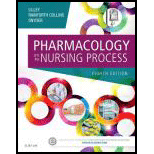
Pharmacology and the Nursing Process, 8e
8th Edition
ISBN: 9780323358286
Author: Linda Lane Lilley PhD RN, Shelly Rainforth Collins PharmD, Julie S. Snyder MSN RN-BC
Publisher: Elsevier Science
expand_more
expand_more
format_list_bulleted
Question
Chapter 26, Problem 5O
Summary Introduction
To Compare:
The laboratory tests that are used in conjunction with treatment with the various coagulation modifiers, implication for the therapeutic use of these drugs, and monitoring adverse effects.
Concept introduction:
The coagulation is otherwise called as clotting. During this clotting process, the blood changes from liquid gel. The forming of blood clot results from hemostasis. Generally, the clotting of blood occurs when the blood vessels are damaged. The coagulation modifier is the drug that takes action on the blood coagulation pathway to prevent or develop the formation of a clot. The coagulation modifiers are anticoagulants, antiplatelet drugs, and thrombolytic drugs.
Expert Solution & Answer
Want to see the full answer?
Check out a sample textbook solution
Students have asked these similar questions
How does cardiac output affect oxygenation?
Which cardiac condition causes you the most concern about providing nursing care to patients who have it?
Please cite in text source and list references
Identify a resource on the future of Medicare for All?
.Identify why this trend is an important trend to monitor and how it relates to reimbursement.
What are potential challenges or opportunities within the industry or your chosen field (if applicable) you feel may result from this healthcare trend. As a healthcare leader, how would you position yourself and your team to overcome the challenges and prepare for the opportunities?
what is health history
Chapter 26 Solutions
Pharmacology and the Nursing Process, 8e
Knowledge Booster
Similar questions
- what is health assessment?arrow_forwardwhat is health assessment in nursing?arrow_forwardClassroom Learning Objectives: Analyze the basic concept of nutrition (MPO 1.1) Discuss factors that affect food choice (MPO 1.2) Define nutrients and classify nutrients according to their work in the body (MPO 1.2) List the functions of water in the body (MPO 1.1) Describe the best practices for assessing a patient’s nutritional needs (MPO 1.2) Identify lab testing that may be completed to assess a patient’s nutritional status (MPO 1.2) Identify select alterations in nutrition with associated manifestations. Describe the multisystem effects of undernutrition (MPO 1.1) Discern when diet modifications may be warranted (MPO 2.3) Apply therapeutic nursing interventions when an alteration in nutritional status is identified. Explain the basic aspects of reading a food label (MPO 1.2) Describe pharmacological treatments of nutritional needs (MPO 1.3)arrow_forward
- Is this sinus arrest,sinus tachycardia,sinus bradycardia,normal sinus ?arrow_forwardRelated research design to answer the clinical question “How registered nurses accurately measure respiratory rates in performing vital sign assessments in hospital?” Provide article title, purpose/aim, methods and key findingarrow_forwardAnything else I should add to this slide and notes? Can you also put the notes into paragraphs with the changes?arrow_forward
- How are the nervous and musculoskeletal systems interrelated? How do central nervous system abnormalities and damage to the musculoskeletal system affect mobility? Please cite in text source and list referencesarrow_forwardAnything else I should add to this slide and notes? Can you also put the notes into paragraphs with the changes?arrow_forwardAnything else I should add to this slide and notes? Can you also put the notes into paragraphs with the changes?arrow_forward
arrow_back_ios
SEE MORE QUESTIONS
arrow_forward_ios
Recommended textbooks for you
 Phlebotomy EssentialsNursingISBN:9781451194524Author:Ruth McCall, Cathee M. Tankersley MT(ASCP)Publisher:JONES+BARTLETT PUBLISHERS, INC.
Phlebotomy EssentialsNursingISBN:9781451194524Author:Ruth McCall, Cathee M. Tankersley MT(ASCP)Publisher:JONES+BARTLETT PUBLISHERS, INC. Gould's Pathophysiology for the Health Profession...NursingISBN:9780323414425Author:Robert J Hubert BSPublisher:Saunders
Gould's Pathophysiology for the Health Profession...NursingISBN:9780323414425Author:Robert J Hubert BSPublisher:Saunders Fundamentals Of NursingNursingISBN:9781496362179Author:Taylor, Carol (carol R.), LYNN, Pamela (pamela Barbara), Bartlett, Jennifer L.Publisher:Wolters Kluwer,
Fundamentals Of NursingNursingISBN:9781496362179Author:Taylor, Carol (carol R.), LYNN, Pamela (pamela Barbara), Bartlett, Jennifer L.Publisher:Wolters Kluwer, Fundamentals of Nursing, 9eNursingISBN:9780323327404Author:Patricia A. Potter RN MSN PhD FAAN, Anne Griffin Perry RN EdD FAAN, Patricia Stockert RN BSN MS PhD, Amy Hall RN BSN MS PhD CNEPublisher:Elsevier Science
Fundamentals of Nursing, 9eNursingISBN:9780323327404Author:Patricia A. Potter RN MSN PhD FAAN, Anne Griffin Perry RN EdD FAAN, Patricia Stockert RN BSN MS PhD, Amy Hall RN BSN MS PhD CNEPublisher:Elsevier Science Study Guide for Gould's Pathophysiology for the H...NursingISBN:9780323414142Author:Hubert BS, Robert J; VanMeter PhD, Karin C.Publisher:Saunders
Study Guide for Gould's Pathophysiology for the H...NursingISBN:9780323414142Author:Hubert BS, Robert J; VanMeter PhD, Karin C.Publisher:Saunders Issues and Ethics in the Helping Professions (Min...NursingISBN:9781337406291Author:Gerald Corey, Marianne Schneider Corey, Cindy CoreyPublisher:Cengage Learning
Issues and Ethics in the Helping Professions (Min...NursingISBN:9781337406291Author:Gerald Corey, Marianne Schneider Corey, Cindy CoreyPublisher:Cengage Learning

Phlebotomy Essentials
Nursing
ISBN:9781451194524
Author:Ruth McCall, Cathee M. Tankersley MT(ASCP)
Publisher:JONES+BARTLETT PUBLISHERS, INC.

Gould's Pathophysiology for the Health Profession...
Nursing
ISBN:9780323414425
Author:Robert J Hubert BS
Publisher:Saunders

Fundamentals Of Nursing
Nursing
ISBN:9781496362179
Author:Taylor, Carol (carol R.), LYNN, Pamela (pamela Barbara), Bartlett, Jennifer L.
Publisher:Wolters Kluwer,

Fundamentals of Nursing, 9e
Nursing
ISBN:9780323327404
Author:Patricia A. Potter RN MSN PhD FAAN, Anne Griffin Perry RN EdD FAAN, Patricia Stockert RN BSN MS PhD, Amy Hall RN BSN MS PhD CNE
Publisher:Elsevier Science

Study Guide for Gould's Pathophysiology for the H...
Nursing
ISBN:9780323414142
Author:Hubert BS, Robert J; VanMeter PhD, Karin C.
Publisher:Saunders

Issues and Ethics in the Helping Professions (Min...
Nursing
ISBN:9781337406291
Author:Gerald Corey, Marianne Schneider Corey, Cindy Corey
Publisher:Cengage Learning